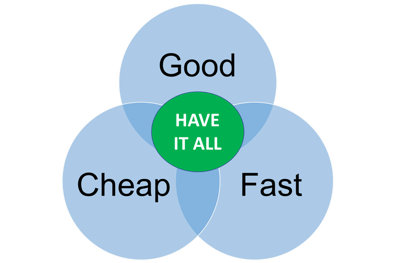Understanding Personalization at Scale: More than a Buzzword, It's a Growth Engine

When I was growing up, my grandmother would test if spaghetti was cooked by throwing it against the wall. If it stuck, that meant it was done. But advertising is not like spaghetti. You can't haphazardly throw ads at consumers and hope some of them stick. You need a strategic approach that combines media and creative targeting with personalized messaging. Using this formula, we've seen as much as a 585% lift in ROI. While the results aren't always so dramatic, to date we haven't seen a negative outcome.
All content is not created equal
Today, consumers are exposed to more ads than ever before — even by conservative estimates, thousands of ads reach them every day. At the same time, they also have higher expectations for concierge-level service and customized experiences from the brands they interact with. But with spam filters and the ability to skip ads, many messages aren't even being seen or heard.
The challenge for brands: How can you have a series of connected, relevant conversations with millions of different consumers?
To do so requires not only a keen understanding of your customers' purchasing patterns and habits — knowing what they want even before they do — but also having the technical capabilities to create individualized messages and reach them at the right moment, in the right place and in the right mindset, as well as the capacity to produce all this content while staying in budget.
Welcome to the world of personalization at scale.
You can have all three
There's an old saying that goes, "You can have it fast, good or cheap: pick two." The implication is that it's impossible to have all three.
With personalization at scale, you no longer have to choose. Marketers now have the opportunity to connect with a greater number of consumers and create more meaningful interactions with them, for a fraction of the cost. According to Harvard Business Review (as well as our own experience), we know that personalization can deliver five to eight times the ROI on marketing spend and can lift sales by 10 percent or more. So, why isn't every brand doing it?
While the value of personalization is well documented, it can be challenging for companies to take the plunge. Fear of change may be part of the reason. The idea of shifting to a new way of doing things can be intimidating, especially if you're not sure where to begin. But the reality is that transitioning to a new solution doesn't mean starting from scratch. Brands can begin with many of the assets they already have, and it's easy to test, learn and adapt along the way.
Best practices for brands
At first, many brands think they're already doing personalization at scale, when in reality they're often doing audience segmentation based on purchase data. Scaling personalization requires a combination of process, people and technology, and is dependent on close collaboration and commitment to working differently. But it doesn't have to be overly complicated. Consider these best practices for brands:
Audience First:Flip the traditional advertising model upside down. Rather than leading with the :60 spot — or any other single piece of content — begin by learning about brands and their customers, and gain a greater understanding of their unique business challenges. Then build on that in data discovery, where brands should look for additional opportunities to reach new creative audiences with more personalized messaging, and then build a content plan to best deliver on those needs.
For example, with one of our CPG clients, our data discovery process helped identify a new factor that could lead customers to purchase their product. This particular benefit hadn't been part of their messaging, because it wasn't something that stood out just from looking at purchase data. Using this new insight, we were able to target incremental creative audiences, resulting in a significant lift in ROI.
Below are some more learnings that emerged.
Smart Production Planning: By anticipating all creative needs early in the creative process, you can ensure you have a plan to efficiently capture all required content. As an initial step, map out who you need to reach, what you want to say to them, what you want to learn as a result, and what assets are required.
While you should use existing assets where possible, employ the "Shoot Once, Use Many" philosophy when you need to capture new content, ensuring that assets can be sliced and diced any number of ways according to all of the audiences you're trying to reach. So, you're not just producing more for less, you're producing smarter.
Powered by Technology: Leveraging tools and technology is a must, including Digital Asset Management systems for visibility into all existing content, Workflow Management tools to expedite review and approval of work, and DCO and Creative Management Platforms to automate creative versioning. When using these tools, you'll move faster, save money and ensure better overall collaboration and control.
By using a Creative Management Platform, brands can deploy large-scale campaigns with sophisticated decisioning and targeting tactics. This enables them to test and deliver unlimited versions of targeted creative based on variables including customer segment, location, browsing activity, or device. This level of personalization, speed and scale would simply not be feasible with a traditional content model.
Continuous Optimization: Staying fresh and relevant to your audience is a fluid process. That's why to maximize effectiveness, you should be constantly diagnosing where things are working well and where they can improve, giving you the capacity to optimize in real time. This enables you to easily refine a message based on a key new insight, or test a new concept.
Get Started
Personalization at scale doesn't have to be an abstract buzzword or a vague, overwhelming concept. By following a few easy steps, brands can move beyond the buzz and begin using content to unlock significant business growth.
- Crawl/walk/run. Begin with an assessment of your current technology platform, available data and assets as well as creative capabilities, and then build the right roll-out plan. But don't wait for perfection. Start small, with existing data and assets to run a pilot, and build from there.
- Embrace change. Making personalization a priority means changing how you work. Success requires commitment from the top, as well as investments in the right data and technology foundations and the ability to operationalize a new model. These upfront investments, and ongoing governance, are what enable brands to plan, execute and scale personalized content. They are key to driving business growth.
- Collaboration is key. Cross-functional teams must be agile and work in lockstep to be successful. Assemble key players across technology, data and analytics, media, creative, production, and strategy teams — across brand, agency and partner organizations — to ensure full alignment from day one.
Click the social buttons above or below to share this story with your friends and colleagues.
The opinions and points of view expressed in this content are exclusively the views of the author and/or subject(s) and do not necessarily represent the views of MediaVillage.com/MyersBizNet, Inc. management or associated writers.


